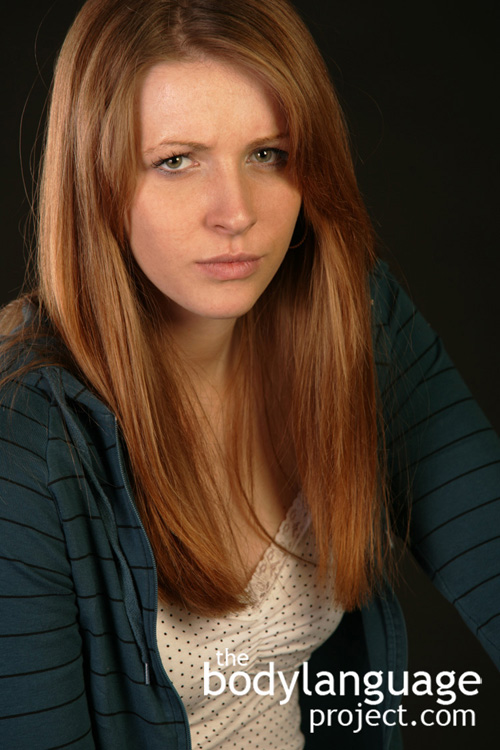Body Language of Eyebrows Knit or Oblique Eyebrows Of Grief
 Cue: Eyebrows Knit or Oblique Eyebrows Of Grief
Cue: Eyebrows Knit or Oblique Eyebrows Of Grief
Synonym(s): Grief Muscle Flex, Worry Facial Expression, Eyebrow Scrunch, Oblique Eyebrows Of Grief.
Description: The eyebrows are raised simultaneously and drawn inward toward each other producing both horizontal creases in the forehead and vertical creases between the eyebrows. In the oblique eyebrows of grief cue, the eyebrows are pulled upward more so than the other ends.
In One Sentence: Knitting the eyebrows together signals grief or physical pain.
How To Use it: Knit the eyebrows by flexing the muscles between the brows. This is most effective when upset or angry and you want someone else to know it. Parents can use this on children, or partners on each other, to show that they disapprove.
Research has shown that children are able to read the facial expressions of adults, and that the messages they carry are more salient to them, than are verbal expressions. In other words, an angry voice is less detectable to children than an angry face so the latter is more effective than the former.
Avoid knitting the eyebrows in airports near security as officers are specially trained to catch grief in high risk situations.
Context: General.
Verbal Translation: “I’m in deep pain due to emotional or physical pain and I’m showing you this by pulling my eyebrows together.”
Variant: See Eyebrow Cock, Eyebrow Hold, Eyebrow Lowering, Eyebrow Flash, Eyebrow Raise.
Cue In Action: At the boarder crossing, he was asked if he carried any drugs with him. He said no, but his eyebrows immediately came together. Spotting his grief, he was detained and questioned. His micro-expression showed that he was probably lying.
Meaning and/or Motivation: When the eyebrows pinch together it is a universal signal of pain, even if it flashes for a split second. Personnel who analyze high-risk events such as boarder crossings, airport security, police officers and detectives are trained to spot momentary expresses of grief. The muscle between the brows can flex at anytime when negative thoughts are held.
The French call the area between the eyebrows, the “grief muscle.” It is active when expressing both pain, as well as when you wish to inflict it. The fearful face carries a momentary raise in the upper eyelids and a grimace comes across the mouth. Anger appears with a lowering of the eyebrows, flaring of the eyes and a tightening of the mouth or jaw.
Fear, grief and surprise in addition to other facial expressions can quickly flash across the face in the form of micro expressions.
Cue Cluster: Eyebrows of grief are combined with other close facial expressions such as lip pursing, squinted eyes, grimacing, as well as nervous cues such as touching the face or ears, scratching the neck, smoothing and adjusting clothing, eye avoidance and even tears in extreme cases.
Body Language Category: Amplifier, Anger, Closed facial gestures, Emotional body language, Negative body language, Stressful body language, Suppressed facial expression.
Resources:
Bonanno, George A. ; Keltner, Dacher Strauss, Milton E. (editor). Facial Expressions of Emotion and the Course of Conjugal Bereavement. Journal of Abnormal Psychology. 1997. 106(1): 126-137.
Bartlett Marian S, Littlewort Gwen C, Frank Mark G, Lee K. Automatic decoding of facial movements reveals deceptive pain expressions. Curr Biol 2014;24:738–43.
Boucher, J D. Facial displays of fear, sadness and pain. Perceptual and motor skills 1969. 28(1): 239-42.
Craig, Kenneth D. ; Patrick, Christopher J. Hogan, Robert (editor). Facial Expression During Induced Pain. Journal of Personality and Social Psychology. 1985 48(4): 1080-109.
Cannon, W. B. (1929). Bodily changes in pain, hunger, fear and rage (2nd ed.). New York: Appleton, Century, Crofts.
Daniele Marzoli, Mariagrazia Custodero, Alessandra Pagliara, and Luca Tommasi. Sun-Induced Frowning Fosters Aggressive Feelings. Cognition And Emotion. 2013; 27 (8): 1513-1521.
http://bodylanguageproject.com/articles/the-sun-can-produce-feelings-of-anger-and-aggression-it-makes-us-frown/
Frijda, Nico H.. What is pain facial expression for? Behavioral and Brain Sciences. 2002. 25(4): 460-460.
Geisser M, Robinson M, Keefe F, Weiner M. Catastrophizing, depression and the sensory, affective and evaluative aspects of chronic pain. PAIN. 1994;59:79–83.
Hermann, Christiane; Flor, Herta. Facial expression of pain more than a fuzzy expression of distress? Behavioral and Brain Sciences. 2002. 25(4): 462-463.
Han, Changsu ; Park, Geun-Young ; Wang, Sheng-Min ; Lee, Seung-Yeop ; Lee, Soo-Jung ; Bahk, Won-Myong ; Pae, Chi-Un. Can botulinum toxin improve mood in depressed patients? Expert review of neurotherapeutics. 2012 12(9): 1049-51.
Keogh E. Gender differences in the nonverbal communication of pain: A new direction for sex, gender, and pain research? PAIN_ 2014;155:1927–31.
Kunz, Miriam ; Mylius, Veit ; Schepelmann, Karsten ; Lautenbacher, Stefan. Impact of age on the facial expression of pain. Journal of Psychosomatic Research. 2008. 64(3): 311-318.
Keogh, Edmund; Holdcroft, Anita. Sex differences in pain: Evolutionary links to facial pain expression. Behavioral and Brain Sciences. 2002. 25(4): 465-465.
Kunz, Miriam ; Peter, Jessica ; Huster, Sonja ; Lautenbacher, Stefan Gray, Marcus (Editor). Pain and Disgust: The Facial Signaling of Two Aversive Bodily Experiences (Comparing Facial Expressions of Pain and Disgust). 2013. 8(12): p.e83277
LeResche, Linda ; Dworkin, Samuel F. Facial expression accompanying pain
Social Science & Medicine. 1984. 19(12): 1325-1330.
McGrath P, Johnson G, Goodman J, Schillinger J, Dunn J, Chapman J. CHEOPS—a behavioral-scale for rating postoperative pain in children. Adv Pain Res Ther 1985;9:395–402.
Pantic, Maja; Rothkrantz, Leon J. M. Machine understanding of facial expression of pain. Behavioral and Brain Sciences. 2002. 25(4): 469-470.
Simon D, Craig K, Gosselin F, Belin P, Rainville P. Recognition and discrimination of prototypical dynamic expressions of pain and emotions. PAIN_ 2008;135:55–64.
Vlaeyen, Johan W.S. ; Hanssen, Marjolein ; Goubert, Liesbet ; Vervoort, Tine ; Peters, Madelon ; van Breukelen, Gerard ; Sullivan, Michael J.L. ; Morley, Stephen. Threat of pain influences social context effects on verbal pain report and facial expression. Behaviour Research and Therapy. 2009 47(9): 774-782.
Walsh, Joseph ; Eccleston, Christopher ; Keogh, Edmund. Pain communication through body posture: The development and validation of a stimulus set. Pain. 2014. 155(11): 2282-2290.
